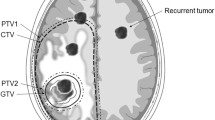Background:
WHO grade II gliomas are often approached by radiation therapy (RT). However, little is known about tumor response and its potential impact on long-term survival.
Patients and Methods:
Patients subjected to RT were selected from the own database of WHO grade II gliomas diagnosed between 1991 and 2000. The volumetric tumor response after RT was assessed based on magnetic resonance imaging and graded according to standard criteria as complete, partial (PR, ≥ 50%), or minor (MR, 25% to < 50%).
Results:
There were 24 astrocytomas and three oligoastrocytomas. 21 patients (78%) were dead at follow-up (mean survival 74 months). None of the patients had chemotherapy. Objective response occurred in 14 patients (52%, five PR and nine MR) but was not associated with overall survival. The vast majority of the tumors had no loss of heterozygosity (LOH) 1p and/or 19q (86%).
Conclusion:
Approximately 50% of patients with astrocytic WHO grade II gliomas respond to RT despite the absence of LOH for 1p/19q. The potential predictive factors for response and the impact of response on overall survival remain unclear.
Hintergrund:
WHO-Grad-II-Gliome werden oft einer Radiotherapie (RT) zugeführt. Über das objektive Tumoransprechen und seine potentielle Auswirkung auf das Langzeitüberleben ist allerdings wenig bekannt.
Patienten und Methodik:
Aus der eigenen Datenbank von WHO-Grad-II-Gliomen wurden die einer RT unterzogenen Patienten eingeschlossen. Das volumetrische Ansprechen nach RT wurde anhand von Magnetresonanztomogrammen gemessen und nach den Standardkriterien eingestuft: komplett, partiell (PR, ≥ 50%) oder gering (MR, 25% bis < 50%).
Ergebnisse:
Es fanden sich 24 Astrozytome und drei Oligoastrozytome. Kein Patient erhielt eine Chemotherapie. Bei der Nachuntersuchung waren 21 Patienten (78%) gestorben (mittlere Überlebenszeit: 74 Monate). Ein objektives Ansprechen wurde bei 14 Patienten verzeichnet (52%, fünf PR und neun MR), was jedoch nicht mit der Gesamtüberlebenszeit korrelierte. Die Mehrheit der Tumoren wies keinen Verlust an Heterozygotie (LOH) 1p/19q auf (86%).
Schlussfolgerung:
Ungefähr 50% der Patienten mit astrozytären WHO-Grad-II-Gliomen sprechen trotz fehlenden LOH 1p/19q auf eine RT an. Potentielle prädiktive Faktoren für das Tumoransprechen und dessen Einfluss auf die Gesamtüberlebenszeit bleiben unklar.
Similar content being viewed by others
Author information
Authors and Affiliations
Corresponding author
Rights and permissions
About this article
Cite this article
Fathi, AR., Vassella, E., Arnold, M. et al. Objective Response to Radiation Therapy and Long-Term Survival of Patients with WHO Grade II Astrocytic Gliomas with Known LOH 1p/19q Status. Strahlenther Onkol 183, 517–522 (2007). https://doi.org/10.1007/s00066-007-1673-6
Received:
Accepted:
Issue Date:
DOI: https://doi.org/10.1007/s00066-007-1673-6




